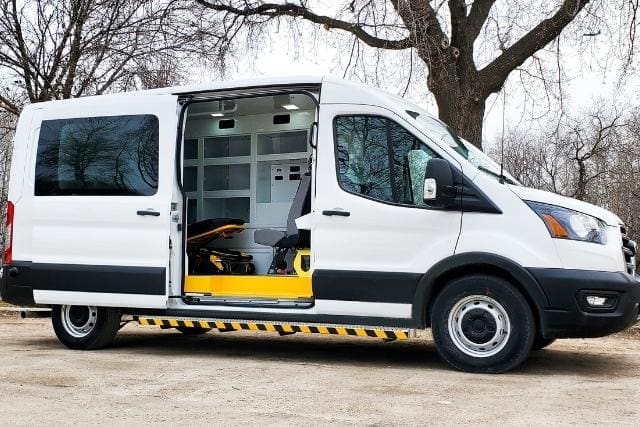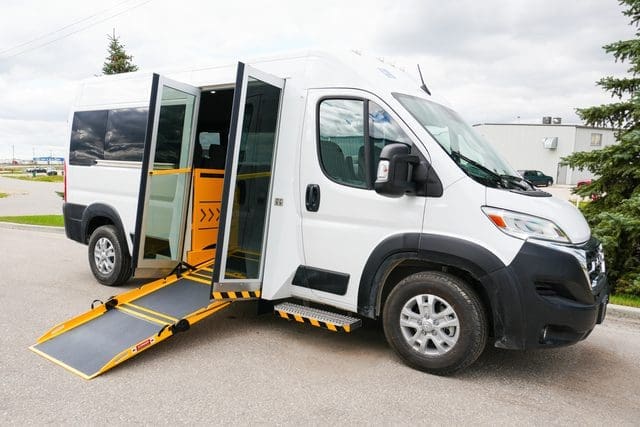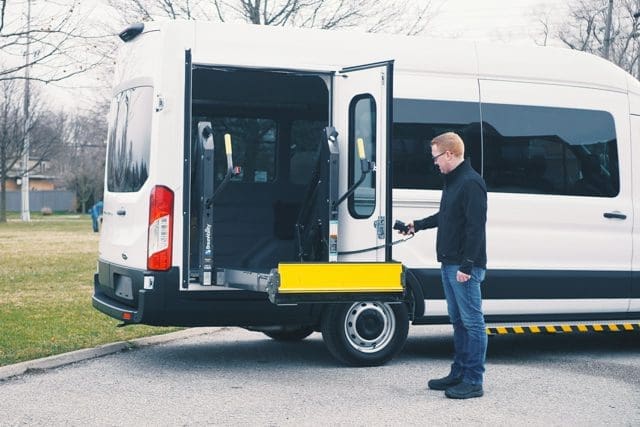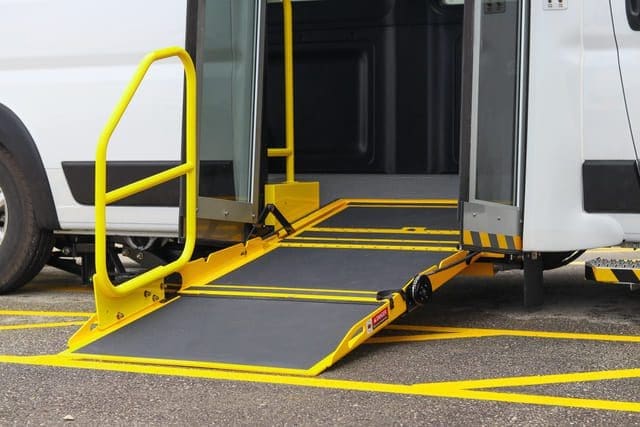Have you ever wondered if using your own vehicle for patient transport is really the best option? Some organizations across Canada use staff or volunteer vehicles to transport people to and from medical appointments.
But here’s the thing: Personal vehicles aren’t made for patient transport. And it could be putting your team, your clients, and your organization at risk. You’re trying to do good, but the vehicle setup is working against you. That gap can lead to injuries, missed appointments, and burnout. It can even damage your reputation.
Now imagine this: You’ve got a safe, comfortable, and professional-looking van that’s built for patient transport. Your team feels supported. Clients feel respected. And your service runs smoother.
We understand where you’re coming from. You care about people. You want to help, but you’re stuck with limited resources and big responsibilities. Our team at MoveMobility has spent over 20 years helping organizations like yours across Canada get the right tools for the job. We build vehicles that break down barriers to healthcare and transportation. We also know we’re not the only ones out there. Our goal is to provide you with helpful advice to make your decision a little easier.
In this article, you’ll learn about the top five problems with using personal vehicles for patient transport. By the end, you’ll have a clearer idea of why a dedicated patient transport vehicle makes more sense.
1. Personal vehicles aren’t built for safe patient transport
Let’s be honest, your car wasn’t made for patient transport. It might get the job done for everyday errands, but when it comes to safely moving people with health concerns, it just doesn’t cut it.
Imagine trying to help someone with limited mobility into the back seat of your sedan. It’s awkward. It’s uncomfortable. And let’s face it, it can even be unsafe. You’re lifting, twisting, and hoping nothing goes wrong. Now think about doing that every single day.
Here’s why personal vehicles don’t work for safe patient transport:
- Poor layout: There’s likely no room in your car for a wheelchair, walker, or medical gear.
- Low entry height: It’s hard for people with pain, injuries, or disabilities to get in and out.
- Risk of injury: Staff and clients can both get hurt. Lifting and bending in tight spaces takes a toll.
- Privacy concerns: Personal vehicles don’t offer any space for confidential conversations or care.
- Unprofessional image: A personal car doesn’t show that your patient transport service is reliable or prepared.
These gaps can lead to missed appointments, staff burnout, and legal issues. A proper patient transport service needs vehicles made for the job. When you switch to a real patient transport vehicle, your staff feel safer, and your clients feel cared for.
2. Personal vehicles limit access to inclusive patient transport in Canada
Across Canada, many home care programs, community health centres, and hospitals rely on staff or volunteers to drive clients to appointments. It seems simple, but it’s actually causing a big gap in access to healthcare.
When you use personal vehicles, you’re forced to say no to certain patients. People who use mobility aids, need extra space, or require help during the ride often can’t be safely transported. That means missed care and growing health issues, especially in remote and rural areas.
This is a big deal in Canada, where access already varies so much. People in rural and Indigenous communities already face bigger challenges getting the care they need. If you’re using a personal vehicle, you’re likely making that gap even wider.
Why personal vehicles make patient transport unfair:
- No space for wheelchairs or stretchers
- Hard to assist clients with special needs
- Not accessible for people with injuries or chronic conditions
- Only works for those who can walk and sit easily
When you use a proper vehicle designed for patient transport, you can serve more people. You stop turning clients away just because your vehicle can’t accommodate them.
Everyone deserves care. A real patient transport solution helps you give it.
3. Personal vehicles blur the lines of liability in patient transport
If something goes wrong during patient transport, who’s responsible? When you’re using a personal vehicle, the answer gets messy, and that can put your organization at risk.
Let’s say this happens:
A staff member is driving a client to a medical appointment. They get into a fender bender. The client has minor injuries. Now the driver’s personal insurance is involved. But was it really a personal trip? Or was it work-related?
In Canada, this kind of grey area can be a legal and financial nightmare. Your staff might not be fully covered. And your organization could be held responsible for damages. That’s a lot of risk for a service that’s supposed to be helpful.
Why is liability a major issue with personal vehicle patient transport?
- Personal insurance doesn’t always cover work use
- No clear safety or inspection standards for personal cars
- Injury claims could fall back on your organization
- Clients could sue if they feel unsafe or harmed
Running a proper patient transport service with vehicles designed for the job helps protect everyone—your clients, your staff, and your organization. It keeps things clear, legal, and professional.
4. Personal vehicles lack the right setup for patient transport
Imagine you’re providing patient transport services and are halfway to a hospital. Your client starts having trouble breathing. You’re in a regular car. No equipment. There’s barely any space to help. No way to safely lay them down or even call for extra support.
That’s the reality many Canadian healthcare workers face every day. When you use personal vehicles for patient transport, you’re rolling the dice with someone’s health. Even short trips can turn urgent fast, especially for clients with chronic illness, mobility issues, or age-related conditions.
Here’s why this is a problem in real life:
- No room for medical equipment or oxygen tanks
- No way to monitor vital signs
- You can’t help someone safely if they collapse or fall ill
According to Statistics Canada, over 1 in 4 Canadians lives with a chronic condition. That means the risk of a medical issue during patient transport services is high and growing.
A dedicated patient transport service with trained staff and equipped vehicles can help keep clients stable and calm if something goes wrong.
5. Personal vehicles send the wrong message about your patient transport service
When a healthcare organization shows up in an old sedan or a volunteer’s minivan, it can affect how people see your patient transport services. Even if your staff are caring and professional, showing up in a personal vehicle doesn’t always inspire confidence.
Think about how that looks to a client or their family:
- “Is this official or even legal?” – It can feel unprofessional or make folks question your service.
- “Is this safe?” – If the vehicle looks worn or cramped, trust starts to drop.
- “Does this person know what they’re doing?” – Even if they do, the car might say otherwise.
In Canada, healthcare organizations—from community support agencies to hospitals—are doing big things to build trust in local communities. Your vehicles are part of that story. They represent your mission and your care.
A dedicated patient transport van tells a different story:
- It looks professional and ready to help.
- It shows your clients they matter.
- It helps you stand out from other services doing the same work.
At MoveMobility, we’ve seen how a purpose-built van can make a huge difference. Not just for safety, but for pride in the work you’re doing. It tells people: We’re here for you, and we take this seriously.
What vehicles make the most sense for patient transport services?
After looking at the problems with personal vehicles, it’s clear that a better solution is needed. Reliable patient transport services need vehicles made for comfort, safety, and flexibility. That’s where purpose-built patient transport vans come in.
At MoveMobility, we offer two main options that fit different needs. Each design caters directly to the needs of real Canadian healthcare providers.
The P4 3-in-1 Van

This van is a smart choice for patient transport services that help a mix of clients. It’s built to carry:
- Wheelchair users
- Ambulatory passengers
- Clients who need to lie down on a stretcher
Why it works:
The P4 is like three vehicles in one. You don’t have to switch between vans or turn clients away. You can transport different people with different needs, all in the same trip.
Learn more about the P4 3-in-1 here
The Mobile Response Van

This van is best for patients who may need some medical attention on the way. It gives your staff more room and flexibility to monitor vital signs, assist with comfort, or handle complex care needs. For example, you can safely store oxygen tanks in the Mobile Response Van, which is helpful for those dealing with chronic lung conditions.
Why it works:
It offers the extra support needed for patients who require continuous care during transport, allowing your team to focus on medical needs while still getting them to their destination safely.
See what the Mobile Response Van offers
Choosing the right fit comes down to what your clients and team need most. Want flexibility? The P4 3-in-1’s got you covered. Need extra support on the road? The Mobile Response Van steps up.
Considering upgrading your patient transport services?
You’ve come here because you know personal vehicles aren’t cutting it anymore for your patient transport services. You’ve felt the pain of unreliable, uncomfortable, and unsafe transport for your patients, and you’re looking for a better solution.
Here’s what you’ve learned from this article:
- Problems with using personal vehicles for patient transport, including safety concerns, lack of flexibility, and higher costs.
- The right vehicles to choose for different patient needs: the versatile P4 3-in-1 van and the support-focused Mobile Response Van.
- How making the switch to purpose-built vehicles improves your service and meets patient needs.
Our goal at MoveMobility is simple: help you improve patient transport with innovative vehicles that prioritize comfort, safety, and efficiency. We’ve helped hundreds of organizations across Canada improve their transport services—now, we’re here to help you.
We are committed to partnering with you in healthcare mobility. If you have questions or need more information, don’t hesitate to click the button below to connect with a mobility expert. We’re always here to guide you toward the best solution for your organization’s needs.
If you’re not quite ready to talk to a mobility expert, feel free to check out some of our other resources to help you learn more, starting with our article on what problems patient transport services can help you solve.
After that, check out our article on what you can use a patient transport van for.








